The Oliver Clubs: Sports and Community in Japanese American Los Angeles
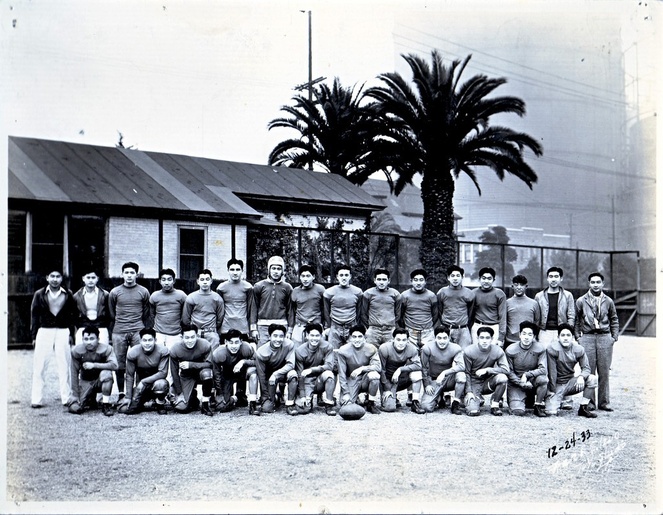
|
||
| Licensing | ||
In 1917, a teacher in the Little Tokyo area of Los Angeles named Nellie G. Oliver began sponsoring a social and athetlic club for local Japanese American youth. Over the next twenty-five years, eight boys' clubs and two girls' clubs were formed under the leadership of the remarkable Miss Oliver, who became so interested in the children and their families that she even traveled to Japan in 1925. The Oliver sports teams excelled in baseball, football, basketball and other sports in Japanese Athletic Union league play, producing talented - and often life-long - athletes. In 1961, the Olivers re-formed to memorialize their teacher and mentor with the annual Outstanding Nikkei Athlete of the Year award for Southern California high school athletes of Japanese descent, a tradition that continued for forty years. This collection presents the story of Miss Oliver and the Oliver Clubs through multiple media, including documents such as a club history and team rosters; photographs of Oliver team members at practice and play; and clips from video interviews with several of the surviving Olivers and one of the Oliver Award winners, who is now playing in the WNBA. This Little Tokyo Service Center (www.ltsc.org) project is made possible, in part, by a grant from the California Council for the Humanities as part of the Council's statewide California Stories Initiative. The Council is an independent non-profit organization and a state affiliate of the National Endowment for the Humanities. For more information on the Council and the California Stories Initiative, visit www.californiastories.org. Any views, findings, conclusions, or recommendations expressed in this online exhibition do not necessarily represent those of the California Council for the Humanities or the National Endowment for the Humanities.
Slides in this album |
|
|
|
History of Miss Oliver and the Oliver ClubsOverview of the history of Miss Oliver and the Oliver Clubs, based in part on Frank Fukuzawa's research and in part on interviews with Olivers.
History of Miss Oliver and the Oliver Clubs |

|
Mr. and Mrs. Peter SuskiMr. and Mrs. Peter Suski circa 1902, just after Mrs. Suski arrived in San Francisco from Japan. Mr. Suski was a photographer at the time, although he later went to medical school at the University of Southern California and practiced in Little Tokyo until the start of World War II. …
Mr. and Mrs. Peter Suski |
|
|
Miss Oliver Describes Little TokyoIn a letter written circa 1923, Miss Oliver describes aspects of Little Tokyo. Although she seems to regard Japanese cultural traditions as exotic and "quaint," she does not refer to them as primitive, pagan, or anti-American, all of which were common epithets used against Japanese immigrants at the time.
Miss Oliver Describes Little Tokyo |
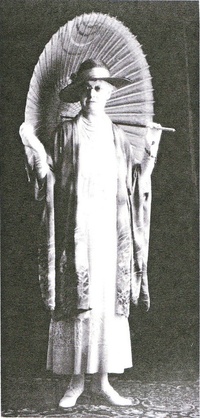
|
Miss Oliver, 1920sMiss Nellie G. Oliver (1861-1947), kindergarten teacher at Hewitt Street School in Los Angeles and sponsor of Little Tokyo's Oliver Clubs, in the late 1920s. Courtesy Visual Communications / Kamayatsu Family.
Miss Oliver, late 1920s |
|
|
Miss Oliver Describes a Fundraising CarnivalIn a circa 1923 letter, Miss Oliver describes one of the carnivals put on by the Olivers to raise money for sports equipment and uniforms. Her passionate belief that the children of Japanese immigrants should be considered fully American - and treated accordingly - comes through here.
Miss Oliver Describes an Oliver Carnival |

|
Miss Oliver's Farewell Party, 1925On July 1, 1925, a farewell party was held for Miss Oliver on the second floor of the Stimson Institute on Hewitt Street in Little Tokyo. The Oliver Clubs met in this room and kept their trophies there; the Daiichi Gakuen Japanese language school met on the first floor. The …
Miss Oliver's Farewell Party, 1925 |
|
|
Oliver Club RostersThe Olivers consisted of nine clubs formed between 1917 and 1941: the Seniors (1917), First Girls' Club (1919), Juniors (1923), Second Girls' Club (1925), Midgets (1928), Tigers (1934), Cubs (1935), Mustangs (1936), and the Broncos (1939). The tenth club, the Beavers, had just begun to form in 1941. Although they …
Oliver Club Rosters |

|
The Olivers in 1925Members of the Oliver Club in the Stimson Institute / Daiichi Gakuen practice yard in 1925. Courtesy Joe Suski.
The Olivers in 1925 |
|
|
Joe Suski, JuniorJoe Suski describes how the Olivers Club came into existence.
Joe Suski, Junior |
|
|
Miss Oliver and ExerciseJoe Suski reveals Miss Oliver's attitude towards posture and exercise.
Miss Oliver and Exercise |
|
|
Community Sings at Union ChurchJoe Suski recalls how Miss Oliver's efforts to teach the children of Little Tokyo to sing were taken up by Charles Kamayatsu (Senior).
Community Sings at Union Church |
|
|
Jack Kunitomi, MidgetJack Kunitomi describes the different parks where the Olivers played games and the process of setting up a league with the L.A. playgrounds director.
Jack Kunitomi, Midget |
|
|
The Oliver Meeting RoomJack Kunitomi describes the Oliver meeting room on the upper floor of the Stimson Institute and how it was used outside their Friday night meeting time.
The Oliver Meeting Room |
|
|
Jack Kunitomi Remembers Miss OliverJack Kunitomi (Midget) remembers how much Miss Oliver meant to him and what she did for Japanese American kids in Little Tokyo.
Jack Kunitomi Remembers Miss Oliver |

|
The Olivers Basketball Team, 1927The Olivers basketball team in the Stimson Institute / Daiichi Gakuen practice yard in 1927. Joe Suski is on the far left of the back row, Gene Sakamoto on the far right. Also in the back row is David Miyamoto (second from left), Masao Itano (middle), Mas Kaizoji (third from …
1927 Olivers Basketball Team |
|
|
An Interview with Miss Oliver, Circa 1924Miss Oliver was interviewed circa 1924 as part of the Survey on Race Relations, a sociological study examining the experiences of "Oriental" - Chinese, Japanese, Filipino, and Sikh - immigrants and their children on the West Coast of the United States. It is clear from her statements that, however progressive …
Interview with Miss Oliver Circa 1924 |
|
|
On the RadioJoe Suski (Junior) remembers Miss Oliver fondly and explains how she was connected with an appearance by some Olivers on local radion in the 1920s.
On the Radio |
|
|
Jack Kunitomi and Union ChurchJack Kunitomi recalls how he "helped" the construction workers building the Union Church on North San Pedro in Little Tokyo in the early 1920s.
Jack Kunitomi and Union Church |
|
|
Little Tokyo EntertainmentJoe Suski (Junior) recalls what he and his family did for fun in the early 1920s in Little Tokyo.
Little Tokyo Entertainment |

|
Juniors Basketball Team, late 1920sThe Oliver Juniors basketball team pose for a picture in the Daiichi Gakuen practice yard, late 1920s. The two young men kneeling in front are Gene Sakamoto on the left and Joe Suski on the right. On the far left in the back row is Paul "Yaz" Yazaki. In the …
Juniors Basketball Team, late 1920s |
|
|
Miss Oliver's Story ActivityJack Kunitomi describes how Miss Oliver's round-robin storytelling activity worked.
Miss Oliver's Story Activity |
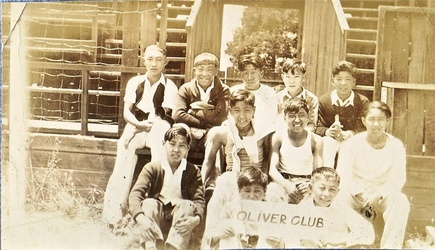
|
Becoming Oliver MidgetsThe Midgets proudly proclaim themselves an Oliver Club, 1929. Jack Kunitomi is in the center of the back row. Courtesy Joe Suski.
Becoming the Oliver Midgets |
|
|
Making New Oliver ClubsJoe Suski explains how additional Oliver clubs came to be formed every few years.
Creating New Clubs |

|
Oliver Juniors Baseball Team, 1929The Oliver Juniors baseball team, 1929 Class "B" champions among L.A.'s Japanese American youth baseball teams. The manager was Jimmy Yamamoto, Joe Suski (middle row, fourth from right) was the captain, and Kenji Kurahara (front row, left) was the mascot. Gene Sakamoto (back row, far left) was the team's coach. …
Oliver Juniors Baseball Team, 1929 |
|
|
Walking Miss Oliver to the StreetcarJoe Suski describes the ritual surrounding escorting Miss Oliver to the streetcar after the Friday night club meetings.
Walking Miss Oliver to the Streetcar |
|
|
Jack Kunitomi's Little Tokyo ChildhoodJack Kunitomi remembers growing up near Central Avenue in Little Tokyo.
Jack Kunitomi's Little Tokyo Childhood |
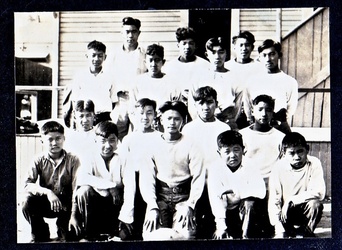
|
Oliver Midgets in the Practice YardThe Oliver Midgets pose in the Stimson Institute / Daiichi Gakuen practice yard in the late 1920s. Jack Kunitomi is third from the right in the back row. Courtesy Joe Suski.
Oliver Midgets in the Practice Yard |
|
|
Weathering the DepressionJoe Suski (Junior) describes the methods by which his family survived the Depression.
Weathering the Depression |
|
|
Oliver OpponentsJack Kunitomi lists the various teams the Olivers played, and the towns - many a long distance from Little Tokyo - where the Olivers went to play. These games provided the young men from Little Tokyo with an opportunity to meet other Japanese American youths from throughout the state.
Oliver Opponents |
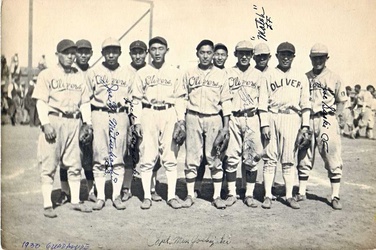
|
Olivers Baseball Team in Guadalupe, 1930The Oliver Juniors traveled to Guadalupe, California to play the local Japanese American team, the Packers, at a game sponsored by George Aratani. At far right is Joe Suski; third from the right is Frank "Match" Kumamoto and to his left is Frank Kito. Third from the left is Joe …
Olivers Baseball Team in Guadalupe, 1930 |
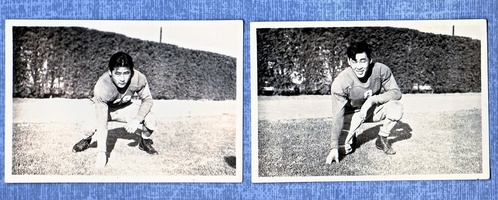
|
Oliver Juniors' Unbeaten SeasonThe Oliver Juniors football team earned a great deal of acclaim with their unbeaten season in 1932. They beat Epworth 13-0, San Pedro 6-0, and Hollywood Showa 6-0. The team of local Hawaiians forfeited, and the Juniors went on to slam Gardena 25-0. The Juniors won the intersectional game against …
Oliver Juniors Unbeaten Season |
|
|
Playing Soko Athletic ClubJoe Suski remembers the long ride up to San Francisco to take on the Soko Athletic Club for the Japanese American state football champions in 1932.
Playng Soko Athletic Club |
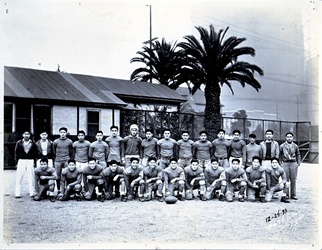
|
Oliver Club Football Team, Christmas Eve 1933Members of the 1933 Oliver football team (mostly from the Juniors and Midgets clubs) in the Stimson Institute/Daiichi Gakuen practice yard, Christmas Eve 1933. The tanks in the background held gas that was piped to cooking stoves throughout the Little Tokyo neighborhood. Courtesy Joe Suski.
Oliver Club Football Team, Christmas Eve 1933 |
|
|
Olivers Post-GameJack Kunitomi (Midget) describes the post-game routine for he and his fellow Oliver pals
Olivers Post-Game |
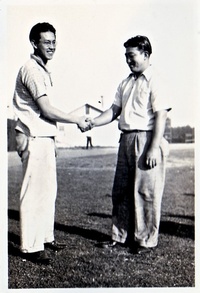
|
Oliver Midgets on the FieldCoaches (?) or managers shake hands before an Oliver Midgets game in the early 1930s. Courtesy Joe Suski.
Oliver Midgets on the Field |
|
|
The Oliver Practice YardJoe Suski describes the Stimson Institute / Daiichi Gakuen practice yard.
Oliver Practices |
|
|
Oliver Practices in the Stimson Institute YardJack Kunitomi describes the hazards of practicing football on the gravel yard behind the Stimson Institute / Daiichi Gakuen yard.
Practice in the Stimson Institute Yard |

|
Olivers at Play, 1933Young Olivers practice their football skills in the Stimson Institute / Daiichi Gakuen yard, 1933. Courtesy Joe Suski.
Olivers at Play, 1933 |
|
|
The Development of the Japanese Athletic UnionJoe Suski recalls how the informal Japanese American youth leagues organized by Mas Satow from the YMCA gave way to the Japanese Athletic Union.
The Development of the Japanese Athetlic Union |
|
|
Harry Yamamoto, CubHarry Yamamoto recalls athletic highlights from the Olivers' glory days on the field.
Harry Yamamoto, Cub |
|
|
Punch, Cookies, and the Social GracesHarry Yamamoto (Cub) describes Miss Oliver's generosity and how she pushed the young men to organize socials with the local Japanese American girls' clubs.
Punch, Cookies, and the Social Graces |
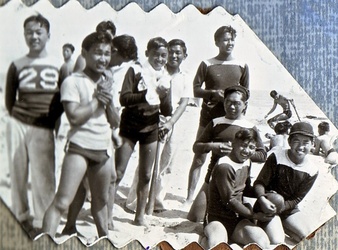
|
Cubs at the BeachMembers of the Oliver Cubs enjoy a trip to the beach, probably at Terminal Island in San Pedro, California, in the mid- to late 1930s. Courtesy Joe Suski.
Cubs at the Beach |
|
|
A Family AffairHarry Yamamoto reveals his family's commitment to the Oliver Clubs.
A Family Affair |
|
|
"Miss Oliver Was Like a Saint"Harry Yamamoto describes how Miss Oliver's kindness to Japanese Americans stood out in the pre-World War II era, when Japanese Americans faced discrimination in housing, employment, and public spaces.
Miss Oliver Was Like a Saint |
|
|
Ets Yoshiyama, BroncoEts discusses lettering at Polytechnic High School and the Olivers' reputation in sports.
Ets Yoshiyama, Bronco |
|
|
RecruitingHarry Yamamoto (Cub) reveals how he went outside Little Toky (and broke some JAU rules) to recruit the best players for Oliver teams.
Recruiting |

|
The Los Angeles Nippons, 1935The Los Angeles Nippons semi-pro baseball team in April 1935. Oliver Junior Joe Suski is fourth from the left in the front row. Suski played baseball at L.A. City College and then UCLA before joining the Nippons. Courtesy Joe Suski.
Los Angeles Nippons, 1935 |
|
|
Playing for the Los Angeles NipponsJoe Suski (Junior) recalls his days playing for the semi-pro team, the Los Angeles Nippons.
Playing for the Los Angeles Nippons |
|
|
Batting ChampionJack Kunitomi describes winning the JAU batting championship in 1936.
Batting Champion |
|
|
Edward Wada, BroncoEd Wada reminisces about being a Bronco, playing football at Heart Mountain, and what being an Oliver has meant to him.
Edward Wada, Bronco |
|
|
A Little Tokyo TragedyEts Yoshiyama recalls a friend who was killed by a train while riding his bike at the corner of First Street and Alameda in Little Tokyo. The many streetcar and train tracks that criss-crossed Little Tokyo made the streets quite dangerous for children, one of the reasons that Miss Oliver …
A Little Tokyo Tragedy |
|
|
Discrimination in HiringHarry Yamamoto discusses how he first learned that college-educated Japanese Americans were not hired at jobs for which they were qualified, and how this discovery prompted him to focus on starting his own business instead.
Discrimination in Hiring |

|
Oliver Cubs at Los Angeles ColiseumMembers of the Oliver Cubs stand on the field of Los Angeles Memorial Coliseum, late 1930s. Courtesy Joe Suski.
Oliver Cubs at Los Angeles Coliseum |
|
|
The NicknamesHarry Yamamoto explains how some of the Olivers ended up with their colorful nicknames.
The Nicknames |
|
|
Raising FundsHarry Yamamoto describes the many methods the Olivers invented to raise funds for their uniforms and equipment.
Raising Funds |
|
|
Raising Funds IIJoe Suski (Junior) describes the methods by which his family survived the Depression.
Raising Funds II |
|
|
Ronnie SugiyamaHarry Yamamoto describes his fellow Cub and business partner, Ronnie Sugiyama. Ronnie was also a former member of the Koyasan Boy Scout troop and a major advocate for the Scouts. He passed away in the fall of 2006.
Ronnie Sugiyama, Cub |
|
|
December 7, 1941Ed Wada remembers where he was when he heard that Pearl Harbor had been bombed by the Japanese.
December 7, 1941 |
|
|
Pearl Harbor Day BallgameJoe Suski remembers playing a game with the Nippons against the Paramount Studio Cubs the afternoon of December 7, 1941.
Pearl Harbor Day Ballgame |
|
|
Reaction to Pearl HarborEd Wada's brother-in-law faces the hysteria unleashed in the military by the Japanese attack on Pearl Harbor.
The Reaction to Pearl Harbor |
|
|
The Wada Family EvacuatesEdward Wada's family was able to retain their property following internment thanks to the kindness of their neighbors, the Weibecks.
The Wada Family Evacuates |

|
Ets and Babe at Heart MountainEts Yoshiyama, left, and Babe Nomura, right, in the internment camp at Heart Mountain, Wyoming in June 1943. Ets is wearing his Oliver Bronco jacket. Babe, though not an Oliver, was a standout Japanese American athlete, eventually playing football for San Jose State. Courtesy Ets Yoshiyama.
Ets and Babe in Heart Mountain |
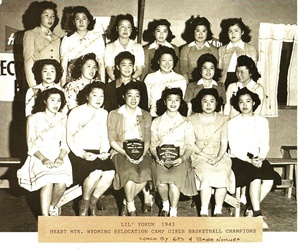
|
Lil' Yokums Team at Heart MountainThe Lil' Yokums Girls Basketball Team, 1943 champions in the internment camp at Heart Mountain, Wyoming. The team was coached by Babe Nomura and Oliver Bronco Ets Yoshiyama. Courtesy Ets Yoshiyama.
Lil' Yokums Team at Heart Mountain |

|
Oliver Broncos in Heart Mountain Internment CampEnough of the young men from the Oliver Broncos club were interned at Heart Mountain, Wyoming, that they were able to field a few teams to play as Olivers. This is the 1942 roster for Broncos on the 145-pound team. Courtesy Ets Yoshiyama.
Broncos in Heart Mountain Internment Camp |
|
|
Santa Fe Internment CampEts Yoshiyama (Bronco) had an uncle who was a doctor in El Paso, Texas. As a community leader, he was picked up by the FBI and held for the duration of the war at the prison camp in Santa Fe, New Mexico. Ets describes what it was like to visit …
Santa Fe Internment Camp |
|
|
Pledge of AllegianceHarry Yamamoto (Cub) explains the difficulty he experienced in coming to terms with the U.S. government's decision to intern Japanese Americans.
Pledge of Allegiance |
|
|
Miss Oliver Visits ManzanarJack Kunitomi describes Miss Oliver's visit to the Manzanar internment camp and her other efforts on behalf of interned Japanese Americans.
Miss Oliver Visits Manzanar |
|
|
Miss Oliver Writes to the Department of JusticeIn 1944, Miss Oliver wrote a letter to the Justice Department's Enemy Alien Control Unit on behalf of Empei Fujita, father of Mustang George Fujita and Bronco Henry Fujita, to advocate for transfer from the Santa Fe prison camp to Heart Mountain, where the rest of his family was interned. …
Miss Oliver Writes to the Department of Justice |
|
|
Bringing Sports to CampJoe Suski describes being in charge of recreation at the Santa Anita Assembly Center and in Heart Mountain internment camp.
Bringing Sports to Camp |
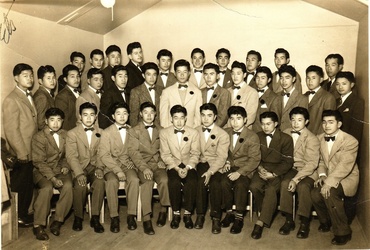
|
Manzaknights Club at the Manzanar Internment CampSeveral Olivers, including Jim Yamaguchi and Hank Sakae (Broncos), joined the Manzaknights Club in the internment camp at Manzanar, California. This picture may have been taken in January 1944. Standing left to right, top: Ray Mochizuki, Nob Hino, Harry Kikuta, Ralph Lazo (a Mexican American who followed his friends into …
Manzaknights Club, Manzanar Internment Camp |
|
|
Kunitomi Family's Military ServiceJack Kunitomi describes his family's military service and some of the hardships related to the wartime draft
Kunitomi Family's Military Service |
|
|
Miss Oliver Writes to Heart MountainMiss Oliver wrote a letter to the Heart Mountain Sentinel, to which she evidently subscribed, in March 1944. Many of the Olivers were interned at Heart Mountain, and Miss Oliver relied on the paper to keep her informed of their activities. Courtesy Harry Yamamoto.
Miss Oliver Writes to Heart Mountain |
|
|
The Baseball Career of Jim YamaguchiEts Yoshiyama describes the baseball career of Jim Yamaguchi, first Nisei to play for a Big Ten school.
The Baseball Career of Jim Yamaguchi |
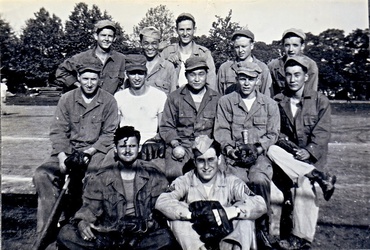
|
Oliver Baseball in JapanOliver Junior Joe Suski and the rest of his Government Section baseball team during the Occupation of Japan around 1946. Joe, a member of the Military Intelligence Service, is second from left in the back row. Courtesy Joe Suski.
Oliver Baseball in Japan |
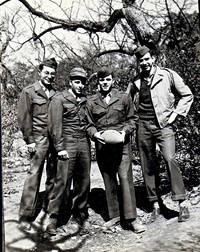
|
Oliver Football in JapanOliver Junior Joe Suski plays football with fellow servicemen in Hibiya, Japan circa 1945. From left are Joe, his friend "Whitey" Lewis, Bob, and "Carp." Courtesy Joe Suski.
Oliver Football in Japan |
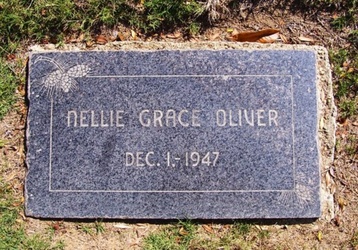
|
Miss Oliver's GraveMiss Oliver's gravesite in Inglewood Park Cemetery, Los Angeles, California. The reconstituted Olivers had hoped to erect a marker to her, but the cemetery rules did not allow it.
Miss Oliver's Grave |

|
Remembering Miss OliverDecember 21, 1960 article about Miss Oliver in the Kashu Mainichi newspaper, written by George "Horse" Yoshinaga. He spoke with Soichi Fukui, an honorary Cub and Little Tokyo businessman, and Frank "Match" and Flora Suski Kumamoto (Juniors and Girls' Club, respectively) before writing this editorial. This article motivated former members …
Remembering Miss Oliver |
|
|
Re-Launching the OliversJoe Suski (Junior) reflects on the experience of losing track of Miss Oliver and the importance of honoring her memory.
Reviving the Oliver Clubs |

|
The Olivers ReturnFollowing George Yoshinaga's December 1960 editorial calling on the Olivers to honor their former mentor, members of the various clubs met on June 21, 1961 to discuss a plan of action. These are the minutes from that meeting. Courtesy Ets Yoshiyama.
The Olivers Return |

|
First Meeting Minutes, Part TwoContinuation of the minutes from the first meeting of the re-formed Olivers Club, June 21, 1961. Courtesy Ets Yoshiyama.
First Meeting Minutes, Part Two |
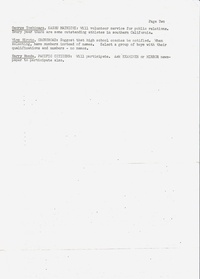
|
First Meeting Minutes, Part ThreeConclusion of the minutes from the first meeting of the re-formed Olivers Club, June 21, 1961. Courtesy Ets Yoshiyama.
First Meeting Minutes, Part Three |
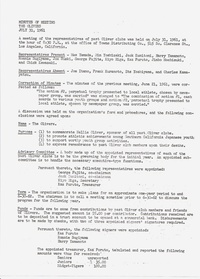
|
Second Oliver Meeting Minutes, Part OneThe re-formed Olivers met for a second time on July 31, 1961 to finalize their plans for an annual reunion dinner combined with the presentation of an award to an outstanding Japanese American high school athlete in honor of their mentor, Miss Nellie G. Oliver. Courtesy Ets Yoshiyama.
Second Oliver Meeting Minutes, Part One |
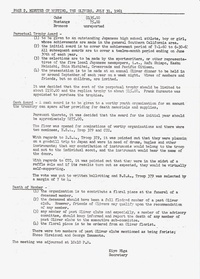
|
Second Oliver Meeting Minutes, Part TwoConclusion of minutes from the second meeting of the re-formed Olivers Club, July 31, 1961. Courtesy Ets Yoshiyama.
Second Oliver Meeting Minutes, Part Two |

|
The Origins of the Oliver AwardThis August 1961 newspaper clipping describes the origins of the reconstituted Olivers as an award-granting association. Courtesy Ets Yoshiyama.
Origins of the Oliver Award |
|
|
The Oliver Award Selection ProcessJoe Suski explains the process set up by the Olivers to select a winner for the Outstanding Nikkei High School Athlete of the Year Award.
The Oliver Award Selection Process |
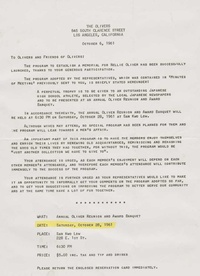
|
Invitation to First Olivers ReunionThe invitation to the first Olivers Clubs reunion dinner and award banquet in 1961. Gift of The Oliver Committee, Japanese American National Museum (2006.76).
Invitation to First Oliver Reunion |

|
First Oliver AwardKenji Takai, a basketball player from Garfield High School, receives the very first Oliver Outstanding Nikkei Athlete of the Year Award on October 28, 1961 at the old San Kwo Low restaurant in Little Tokyo. Kenji is in the middle, receiving the award from John Ando, first president of the …
First Oliver Award |
|
|
Oliver Award Winners, 1961-2001List of all forty-two winners of the Oliver Outstanding Nikkei Athlete of the Year Award for Southern California between 1961 and 2001.
Oliver Award Winners, 1961-2001 |
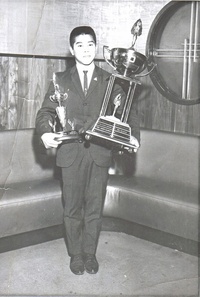
|
Oliver Award Winner Masato SakamotoMasato Sakamoto, a gymnast from Los Angeles High School, won the Oliver Award in 1965. He is shown here holding the small trophy, which he kept, and the large Oliver trophy on which the names of all Oliver Award winners were engraved. The Oliver Trophy is now on display in …
Oliver Award Winner Masato Sakamoto |
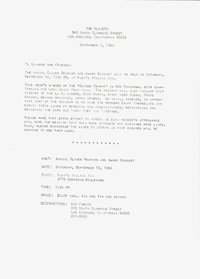
|
Invitation to 1966 Award BanquetThe invitation sent to all Olivers for the 1966 award and reunion banquet at Rudi's Italian Inn. Courtesy Ets Yoshiyama.
Invitation to the 1966 Award Banquet |
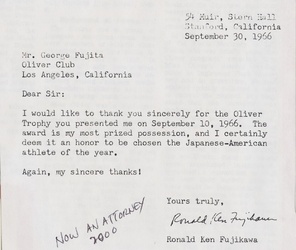
|
Oliver Award Winner's AppreciationRon Fujikawa won the Oliver Award in 1966 for his excellence on the football field at Wilson High School in Long Beach, California. He wrote this note of appreciation to George Fujita, head of the award committee, from Stanford University. As the handwritten note by Jack Kunitomi indicates, he is …
Oliver Award Winner's Appreciation |
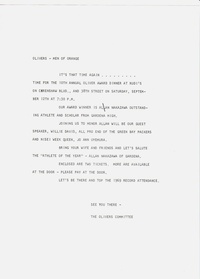
|
Invitation to 1970 Oliver Award BanquetInvitation to the 1970 Oliver award and banquet dinner, with guest speaker Willie Davis, the All Pro end for the Green Bay Packers. Courtesy Ets Yoshiyama.
Invitation to 1970 Award Dinner |
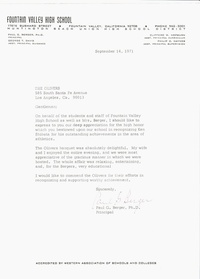
|
Principal's Letter of AppreciationA letter of appreciation to the Olivers from Paul Berger, principal of Fountain Valley High School. Berger's student, Ken Shibata, won the 1971 Oliver award for football, so Berger and his wife attended that year's Oliver banquet. Courtesy Ets Yoshiyama.
Principal's Appreciation for Olivers |

|
Thanks of an Award Winner, Part OneA letter of thanks from Perry Morita, 1976 Oliver Award winner in football from Servite High School. Courtesy Ets Yoshiyama.
Thanks of an Award Winner, Part One |

|
Thanks from an Award Winner, Part TwoConclusion of thank you note to the Olivers from Perry Morita, 1976 Oliver Award winner from Servite High School. Courtesy Ets Yoshiyama.
Thanks of an Award Winner, Part Two |
|
|
Choosing the Oliver Award WinnersEd Wada describes fellow Bronco Jim Yamaguchi's role in choosing the candidates for the Oliver Award each year. Yamaguchi was just one of several Olivers who went into teaching.
Choosing the Oliver Award Winners |

|
Olivers EditorialIn this 1983 newspaper clipping, Rafu Shimpo sportwriter Chris Komai discusses the fact that the Olivers Club will eventually cease to exist. Courtesy Ets Yoshiyama.
Olivers Editorial |

|
Olivers Golf TournamentsReservation form for the 15th annual Olivers golf tournament in 2000. Many of the Olivers, ever interested in sports, had taken up golf during their later years, which gave the club officers the idea of putting on a golf tournament every year to raise money for a scholarship to accompany …
Scholarship Golf Tournament, 2000 |
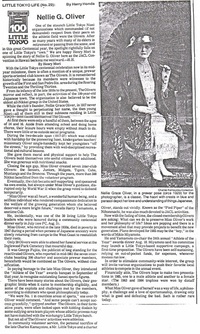
|
Tribute to Miss OliverAs part of his collection of Pacific Citizen columns on Little Tokyo's history during its centennial celebrations in 1984, Harry Honda asked Henry Mori to write an article about the Olivers - this clipping was the result. Mori was a newspaper columnist who became an honorary Oliver through his support …
Tribute to Miss Oliver |

|
Letter from Oliver Award Winner, Part OneLetter of thanks written to the Olivers by 1988 Oliver award winner Jade Hiramoto, who excelled in both basketball and volleyball at North Torrance High School. Courtesy Ets Yoshiyama.
Letter from Oliver Award Winner, Part One |
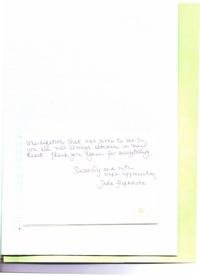
|
Letter from Oliver Award Winner, Part TwoConclusion of Jade Hiramoto's letter of thanks to the Oliver Club in 1988. Courtesy Ets Yoshiyama.
Letter from Oliver Award Winner, Part Two |
|
|
Olivers Booklet, Part OneFrank Fukuzawa researched and wrote a pamphlet on the history of Miss Oliver and the Oliver Clubs in 1990, on which this online exhibit is based. The first half, linked here, provides an extensive history of Miss Oliver and her family, as well as of the Stimson Institute where the …
Olivers History Booklet by Frank Fukuzawa |
|
|
Olivers Booklet, Part TwoFrank Fukuzawa researched and wrote a pamphlet on the history of Miss Oliver and the Oliver Clubs in 1990, on which this online exhibit is based. The second half, linked here, provides a list of all the members of the Oliver teams, along with updates on the occupations and residences …
Olivers Booklet, Part Two |
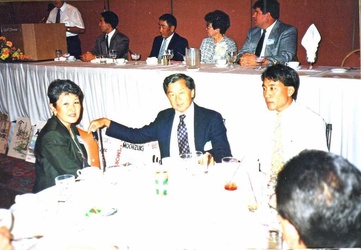
|
1993 Oliver Award BanquetOlivers and friends attending the 1993 Oliver award and reunion banquet. Courtesy Ets Yoshiyama.
1993 Oliver Awards |

|
Enjoying the 1993 Olivers ReunionOlivers and friends enjoying lunch at the 1993 award and reunion banquet. At center is Jack Kunitomi (Midgets). Beyond him are the boards filled with Oliver-related photos and news clippings that Jack brought to each year's banquets, so that wives, friends, and others could catch up on the story of …
Enjoying the 1993 Oliver Reunion |
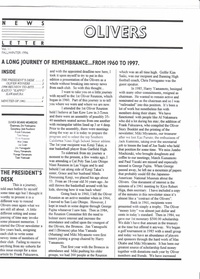
|
The Work Behind the Oliver AwardEts Yoshiyama recalls how he became involved in the re-formed Olivers Club, and the roles played by various other members in organizing the award and reunion banquet each year. Courtesy Ets Yoshiyama.
The Work Behind the Oliver Award |
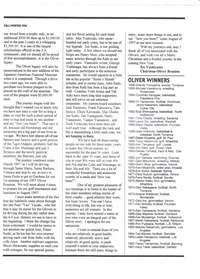
|
The Work Behind the Oliver Award...(continued)Ets Yoshiyama continues his reminiscences about re-starting the Oliver Club in the 1960s. Courtesy Ets Yoshiyama.
The Work Behind the Oliver Award...(continued) |
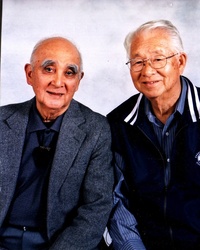
|
Jim Yamaguchi and Ets Yoshiyama, BroncosJim Yamaguchi and Ets Yoshiyama, Oliver Broncos and lifelong friends. Ets was a strong all-around athlete, while JIm played baseball for Northwestern University. Jim Yamaguchi followed in Miss Oliver's footsteps, becoming a high school math teacher in Los Angeles. Courtesy Ets Yoshiyama.
Jim Yamaguchi and Ets Yoshiyama, Broncos |
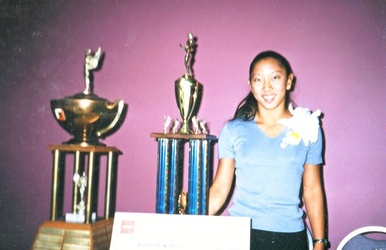
|
1998 Oliver BanquetNatalie Nakase accepts the Oliver Outstanding Nikkei Athlete of the Year Award at the 1998 Oliver reunion banquet. Natalie was a basketball player at Marina High School, and went on to play for UCLA. She is now working on a WNBA career. Courtesy Jack Kunitomi.
1998 Oliver Banquet |
|
|
Oliver Award Winner Natalie NakaseNatalie Nakase, a basketball player for Marina High School, won the Oliver Outstanding Nikkei Athlete of the Year award in 1998. She went on to play basketball with UCLA, coach Japanese American youth basketball, and train with the WBNA. She discusses what it meant to her to win the Oliver …
Oliver Award Winner Natalie Nakase |
|
|
Oliver Award Winners Express AppreciationEts Yoshiyama recalls how several past award winners attended the final program in 2000 to express their appreciation for the organization's efforts on behalf of Japanese American athletes.
Oliver Award Winners Salute the Oliver Clubs |
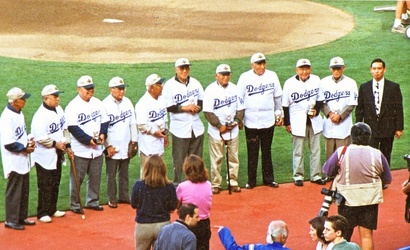
|
Japanese American Baseball Legends0n June 10, 2000, the Los Angeles Dodgers honored several Japanese American baseball legends, including former Olivers Joe Suski (Juniors) and Ets Yoshiyama (Broncos), at Dodger Stadium. Joe is on the far right; Ets is fifth from the right. Courtesy Jack Kunitomi.
Japanese American Baseball Legends |
|
|
Japanese American Baseball LegendsEts Yoshiyama describes being honored as a Japanese American Baseball Legend at Dodger Stadium in June 2000.
Japanese American Baseball Legends |
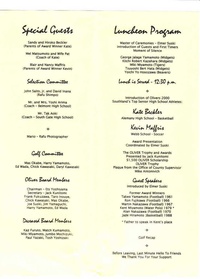
|
Program from Final Olivers LuncheonProgram from the last official Olivers award and reunion banquet on July 29, 2000 at the Quiet Cannon Restaurant. The Olivers handed out one last award in 2001, in conjunction with the annual JACL honors dinner, but did not put on an awards banquet that year. Courtesy Ets Yoshiyama.
Program from Final Olivers Luncheon |
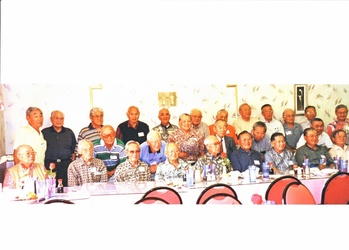
|
The Final Olivers ReunionsThe surviving Olivers at one of their last reunions in the early 2000s. Back row, left to right: Jack Kunitomi, Haruo Kuma, Shiro Nagata, Mas Yoshiyama, Jim Yamaguchi, Edward Wada, Tosh Yashimoto, Chick Kawasaki, Haruo Fujitsubo, Yas Kamei, Kenji Taniguchi, and Harry Yamamoto. Middle row: Freddie Funakoshi, Elmer Suski, Ronnie …
The Final Olivers Reunions |
|
|
The Olivers ReunionsEd Wada (Bronco) looks ahead to the final Olivers luncheon.
The Oliver Reunions |
|
|
Medal of HonorHarry Yamamoto reflects on what Miss Oliver meant to him and other young Japanese Americans in Little Tokyo.
Medal of Honor |
|
|
The Impact of the OliversJoe Suski (Junior) reflects on what being an Oliver has meant to him.
The Impact of the Olivers |
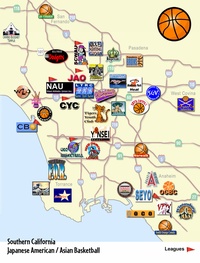
|
Southern California Japanese American Basketball LeaguesThe important role of sports in the Japanese American community that the history of the Oliver Clubs represents continues today, as seen in this overview of the numerous basketball leagues for Japanese American youth in contemporary Southern California. Courtesy Mike Murase.
Southern California Japanese American Basketball Leagues |

|
May 19, 2007 Olivers EventThe audience gathers at the May 19, 2007 community forum unveiling the Olivers exhibit. Photo courtesy Takao Suzuki.
May 19, 2007 Olivers Event |

|
The Olivers Examine Their HistoryMembers of the Olivers, along with family and friends, examine the physical exhibit dedicated to their story, May 19, 2007. The exhibit is located in the lobby of the DISKovery Center in the Far East Building, Little Tokyo. Photo courtesy Takao Suzuki.
Olivers Examine Their History |
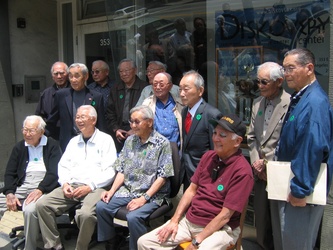
|
The Olivers, 2007Members of the Olivers pose for their portrait outside the Olivers exhibit, May 19, 2007. The Oliver Trophy can be seen in the window behind them. Standing, from left to right are: Tets Morimoto, Jack Kunitomi, Edward Wada, Chick Kawasaki, Kimbo Kunitomi, Frank Shoda, Kaname Kawamura, Joe Suski, and Frank …
The Olivers, 2007 |
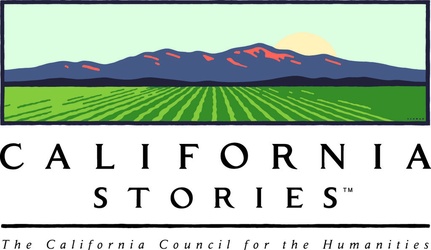
|
The California Story Fund"The Oliver Clubs: Sports and Community in Japanese American Los Angeles" was funded in part by a California Story Fund grant from the California Council for the Humanities. For more information, visit www.calhum.org.
California Story Fund |
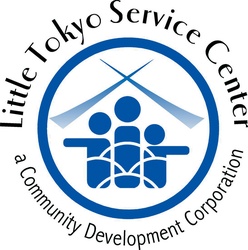
|
Little Tokyo Service CenterThe Little Tokyo Service Center initiated and supervised The Olivers Project. For more information, visit www.ltsc.org.
Little Tokyo Service Center |
 lthistory
lthistory
 Kawafuku Restaurant, Los Angeles, CA
Kawafuku Restaurant, Los Angeles, CA The Oliver Clubs: Sports and Community in Japanese American Los Angeles
The Oliver Clubs: Sports and Community in Japanese American Los Angeles Koyasan Buddhist Temple Collection
Koyasan Buddhist Temple Collection Little Tokyo Walking Tours
Little Tokyo Walking Tours
 Journal feed
Journal feed
